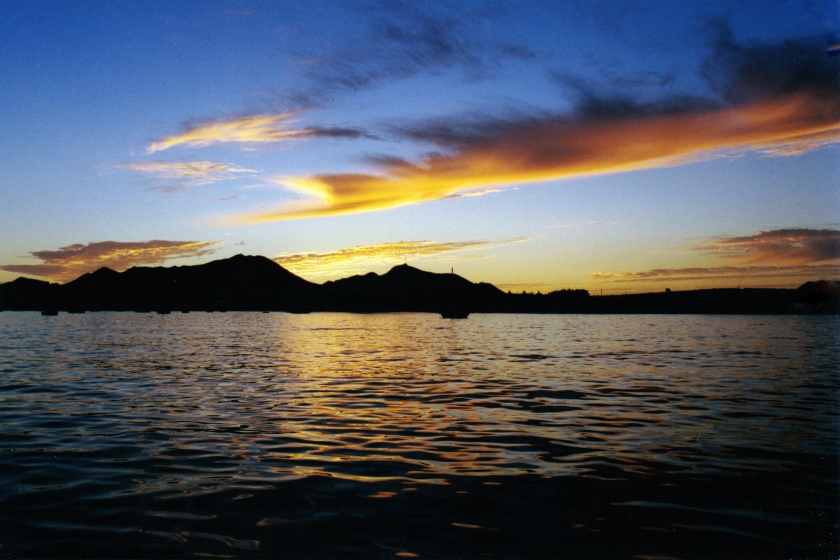
For every thrill ride we took on the outer waters, for every sleepless night we spent at a rocky anchorage, for all the times we doubted our sanity, we got the Sea of Cortez as our reward. Pulling into Cabo San Lucas marked the completion of the first stage of our cruise and it was definitely time to celebrate. However great it was to be back in the “big city”, it was clear that we would have to move on or quickly go broke. Our ultimate goal was to visit the islands in the vicinity of La Paz and La Paz itself.
We left Cabo on the morning of Feb. 18 and proceeded to motor up the east cape. We caught enough wind off San Jose Del Cabo to shut the engine down and sail for about twenty minutes that morning. Shortly after midday, we ran into a sizable chop with no wind. Well ahead in the distance we could see white caps indicating winds of at least 15 knots. Once we had Los Frailes in sight it was wind on the nose at 15 to 20 gusting to 25.
On the way up we caught our first sight of the sea’s somersaulting manta rays. For no discernible reason, these things launch themselves several feet in the air. They do it four or five times in a row and then stop. We even watched a pair alternate a half dozen jumps within a few feet of each other. We were also treated to the sight of a young humpback whale doing his best to match the mantas. What he lacked in height was more than made up for with enthusiasm.
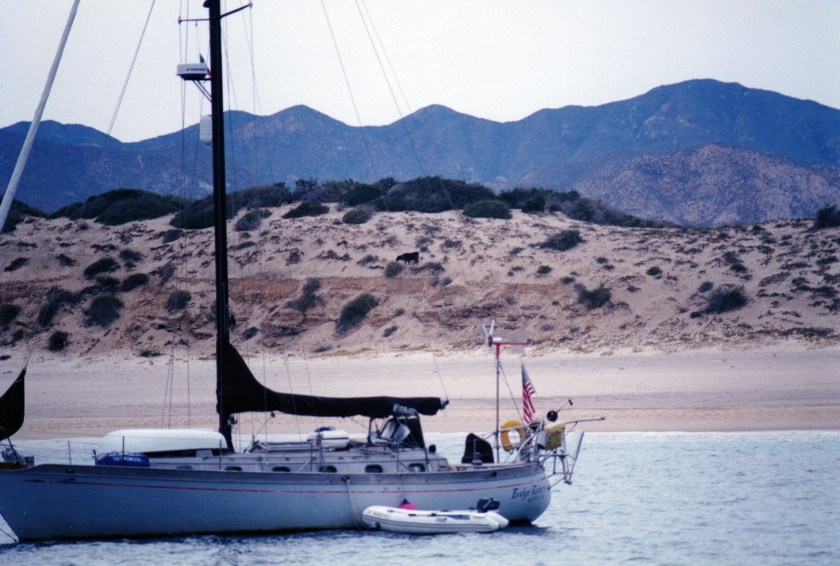
The first stop, Los Frailes, is so well protected from northerly winds it is like anchoring in a bathtub. This is also the first anchorage that is unaffected by Pacific swells. The RVs parked at the west end of the cove give the place the look of a small town after the sun goes down and the lights come up. Apparently this is the way the inside coast is going. First a fish camp, then a landing strip, the RVers create a parking lot, then a hotel pops up… We spent nearly a week here waiting for the wind to ease enough to allow us to continue north. We made the mistake of trying to breakout without checking on the net forecast. We made it as far as the resort at Los Barilles where some fishermen in a small open boat flagged us down. It turned out that their electrical system was dead and they couldn’t start their engine or radio for help. We towed them back to their mooring just before the wind started blowing 30 to 35. We had to beat a hasty retreat back to Los Frailes ourselves.
We got the break we needed on the 23rd. We motorsailed up to Los Muertos in a 5 to 7 knot southerly making for one of the easiest legs of the entire cruise. At one point with about 7 miles to go, we spotted more white caps. With the trip up from Cabo still fresh in our minds, we prepared for the worst. It turned out to be nothing more than a huge school of dolphin.
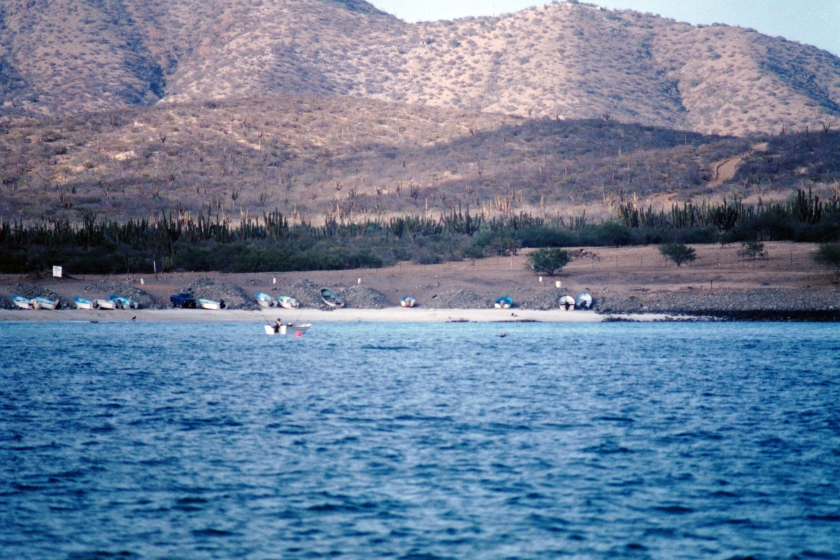
We dropped anchor in 25 feet of water so clear that you could see the chain on the bottom to the point where it disappeared into the sand. The “sands” that makes up the bottom and the beaches from here on in are mainly made of crushed shell and gravel. Since the sea lacks the normal swell action of the Pacific only wind driven water acts to break up the rocks and shells. The normal fine sand that is so prevalent on the Pacific side is only found on the most exposed beaches. The remnants of an old stone pier still remain here but a tractor was bulldozing a bigger parking lot for RVs and a small resort is or was going up at the west end.
We left on the 25th on a forecast of light and variable to make for La Paz. The wind was, in fact, light and variable but the direct approach is through the Cerralvo Channel. It’s a funnel formed by the mountains on the peninsula to the west and the mountains of Isla Cerralvo to the east. The wind built from 10 at the lower end to 20 at the choke point. However, it eased to 5 to 7 quickly after we broke through. On a normal winter’s day, the prevailing 15-knot northwesterly wind can accelerate to 30 and more in here. We consider ourselves lucky and push through.
Rather than head directly into La Paz we stopped at Puerto Balandra for two nights just to catch our breath and check out El Hongo, the mushroom rock for which La Paz is well known. Unfortunately, the camera was doused while trying to shoot film of the dancing humpback. Everyone tries to get a frame showing their boat anchored off the rock. We now have an excuse to go back.
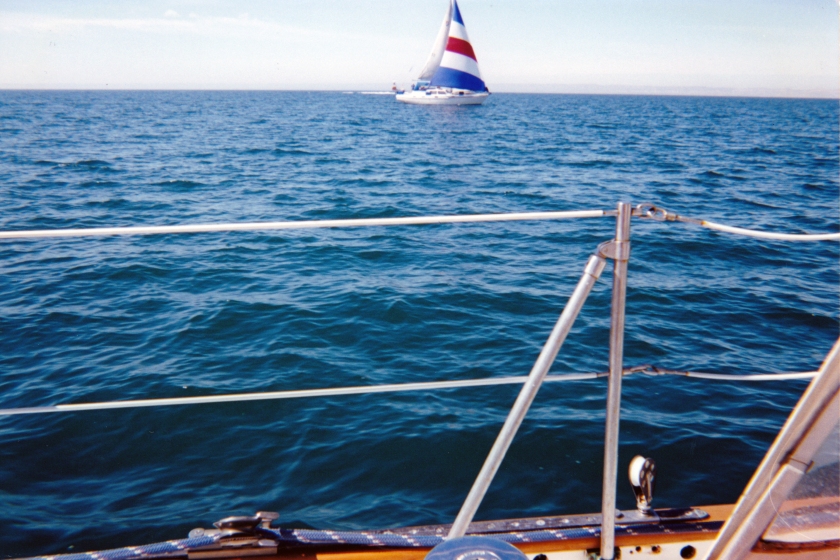
La Paz is also known for the sand bar that has to be negotiated and nothing you can read will prepare you for the reality of navigating the bay. Luckily we happened across a boat “Quasar” with “Local Knowledge” making their way in at the same time we were. In fact, they almost ran us down, but we hailed them and they were more than happy to show us which rusty buoys were red and which black and white buoys were actually green. They also showed us the impromptu range marks which lead to the El Mogote anchorage. That much didn’t really matter because Marina de La Paz turned out to be the most reasonable deal in all of Baja.
After Monica and Eldon on “Quasar” lead us into the channel they also introduced us to another facet of life in La Paz, which is that everyone is universally friendly and genuinely interested in helping each other out. After we tied up in the marina many more strangers came up to us simply to welcome us or to chat or remind us that it was the last night of Carnival and we shouldn’t miss it. In case you’re wondering Marina de La Paz charged us 25 bucks a night for a four-night stretch. You can also tie up for 3 bucks an hour and use the water and power. Dinghy landing privileges are a buck a day or about 10 dollars a month.
Carnival was well worth the price of admission (free) if for no other reason than we were quickly introduced to the real Baja. Of course, the parade and other festivities were very engaging because whatever they lacked in finesse they more than made up for in warmth and energy. Even the Modello and Tecate beer people buried the hatchet long enough participate in the sight of each other. According to locals, this isn’t always the case. Earlier in the week, the parade had been split into two distinct segments because the planners made the mistake of putting their floats next to each other.
Provisioning in La Paz turned out to be downright fun. We walked the 10 blocks to the CCC (pronounced say-say-say) supermarket, stocked up, and took a 30 peso taxi ride back. There’s a carniceria within walking distance which was recommended by people in the marina and we’re glad we tried it. We asked for T-bones and the butcher walked into the freezer and came out with a foot and a half of T-bone. We told him how thick to cut them and he went to the saw and did just that. We bought 6 inch and a quarter thick steaks at 62 pesos a kilo or about 3 dollars a pound. They were tender and absolutely delicious. We came back and bought ribeyes at 84 pesos a kilo and they were lean, boneless, tender and just as good. In fact, there’s not much you can’t get in La Paz. There are several ice cream stands on the Malecon where you can get the standard US brands and flavors, as well as hand made Mexican ones. My digestive tract no longer works with milk but the Mexican ice cream gave me no problems. At Lopez marine, we were able to lay a new supply of Scubs at the same price as back home and we ordered a water pump impeller for the outboard that only took three weeks to arrive. Scubs for the uninitiated are baggies for making ice cubes.
Booze is another story. Jack Daniels costs close to 40 dollars a fifth. A good blended scotch is roughly the same. A single malt scotch… well, we won’t go there today. I like good simple cheap jug wines for the table. A 5-liter box of Peter Vella white zin or chardonnay goes for 7.99 at Smart and Final. The closest thing in Baja is Padre Kino Tinto or Blanco which costs 95 pesos (10.00 dollars) for a 2-liter bottle. The local cruisers mix Padre Kino with Springfield grapefruit soda to make a sort of wine cooler. Stick to tequila and beer. Cheap brands of tequila for mixing are just that, dirt cheap. Jose Cuervo is the only brand I recognize on both sides of the border and in La Paz its one-third less. Wait for the ofertas and save even more. Mexican beers cost the same on either side, about 75 cents a bottle. You can also get Bud or Millers but it’s a bit more.
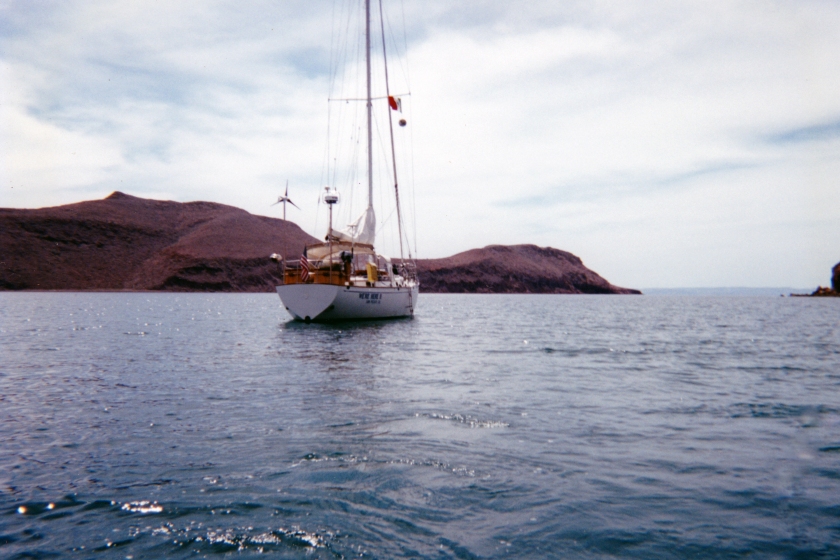
On March 5th, we sailed to Caleta Partida which divides Isla Espiritu Santo and Isla Partida in the company of “Quasar” and stayed for the better part of a week. The forecasts were for more northerly weather so we just sat it out, amusing ourselves by exploring the tidal flats, snorkeling, and acting like idle rich. The only weather we actually experienced were late night and early morning southerlies. The southerlies actually originate on the Pacific side of the peninsula and come roaring across the lowlands that separate it from La Paz giving the locals a chance to cool off and rest up.
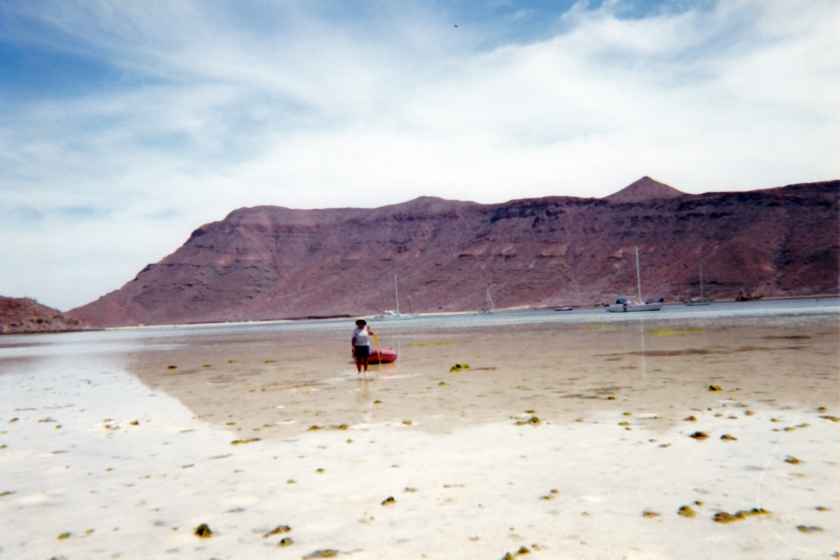
We motored the 20 miles north to Isla San Francisquito in a very light northwest breeze. This island is made up of alternating layers of green sedimentary deposits and red volcanic flows. Crushed shell and gravel make up the more exposed beaches while the more protected are mainly baseball sized rock. On the southern edge of the island, we found agates, quartzite crystals and a couple of good sized geodes. One boat shared several fish they caught while out snorkeling the northern coves. We had a potluck on “Quasar” with fish tacos of red snapper and triggerfish. The weather forecast had us moving to the north end of the main anchorage to ride out a predicted norther that never happened. We did get hit by a 20+ knot southerly that made us move back to the south end of the cove on a day when the forecast was for light and variable. Luckily it blew out in about 12 hours.
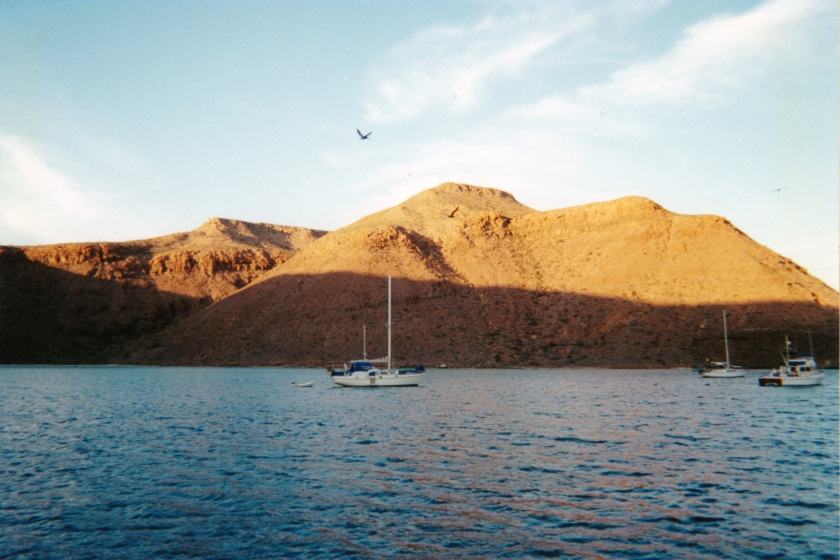
We had our best sail ever between Isla San Francisquito and the northernmost bay of Puerto Ballena in Isla Espiritu Santo. We had 12 to 15-knot winds over our port quarter the entire way. Puerto Ballena is unremarkable in that it is just as beautiful an anchorage as any we’ve visited so far. We spent three nights here doing what everyone else does, using up the last of our supplies before we made the final trek back into La Paz.
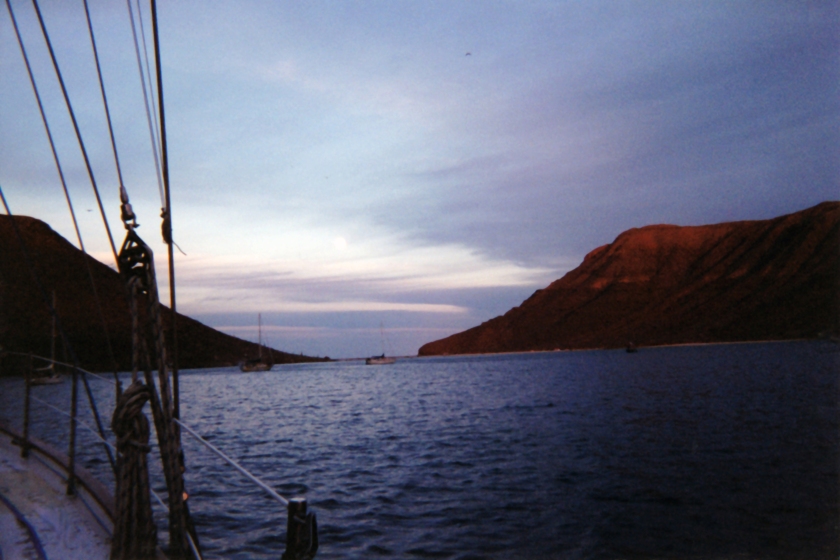
We returned to La Paz on the 21st after having spent a little more than 2 weeks at three different anchorages. We used up two-thirds of our water, burned one-quarter of our fuel load and went through about $150.00 U.S. in groceries. We were extravagant. We could have easily cut that in half and still put on weight. We didn’t take advantage of the shrimpers that often came by with fresh fish and shrimp for sale. A kilo of giant shrimp caught just the night before goes for 100 pesos (about $10.50 U.S.). Several people had water makers and welcomed us to any water we needed. This is the way of life for a lot of cruisers. They go in, stock up, and leave. You can’t spend a lot of money underway and if you like sailing, well… sometimes you can do that too.
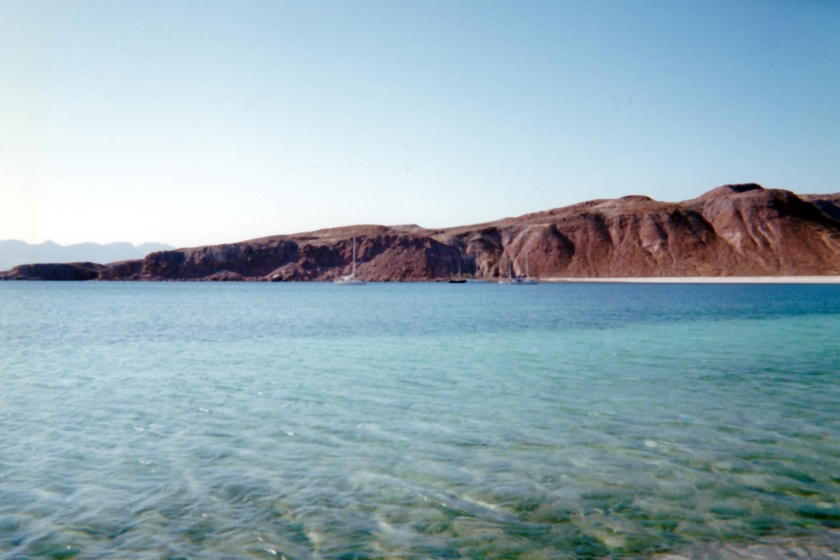
Unfortunately, summer came to La Paz and we started provisioning for our return home. The nights are quite bearable but during the day we do as the locals do, as little as possible to beat the heat. A number of people just sail north to San Carlos and store their boats there until the next winter. Several more boats are stored in the marinas here or on moorings or on the hard at one of the boatyards. We will miss La Paz and the people here more than anything. It has been just what novice cruisers like ourselves need to take some of the rough edges off our education.